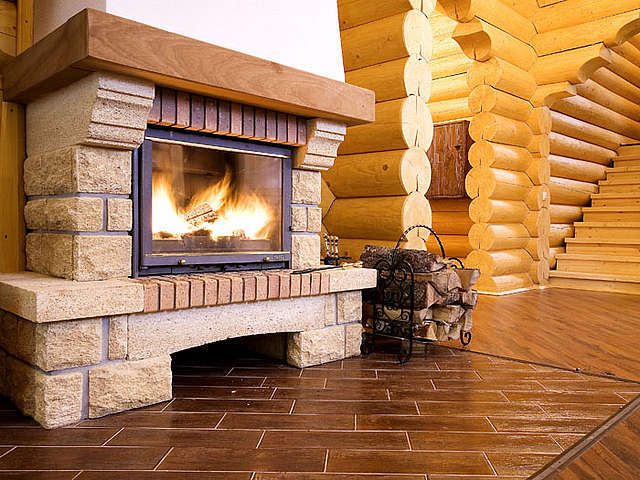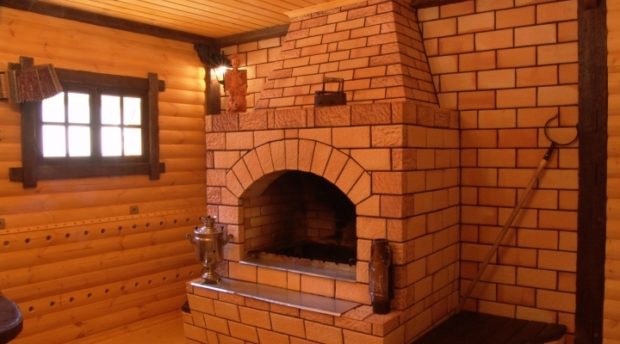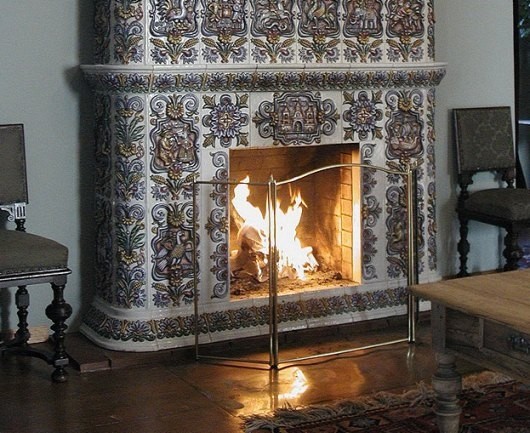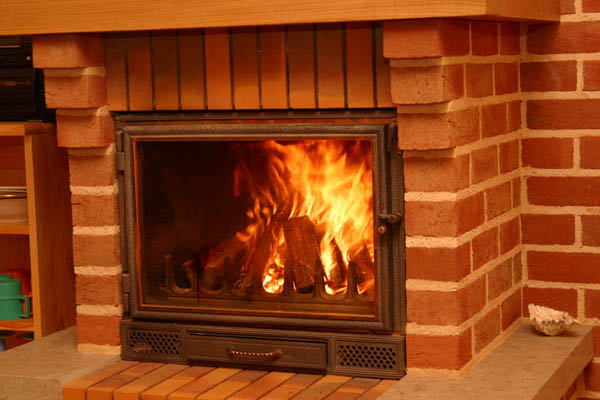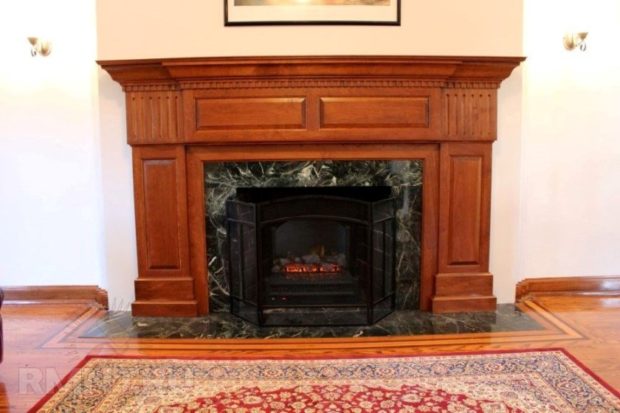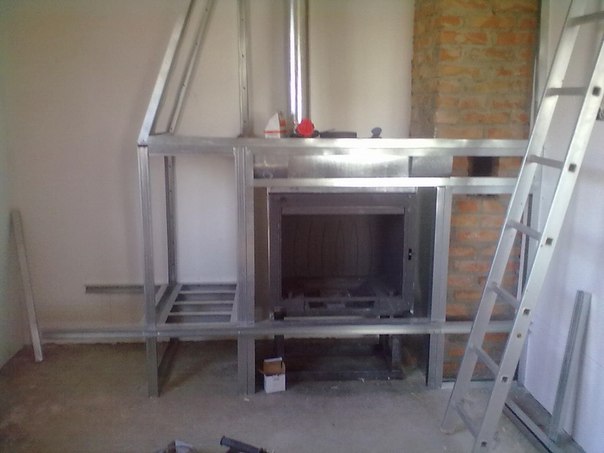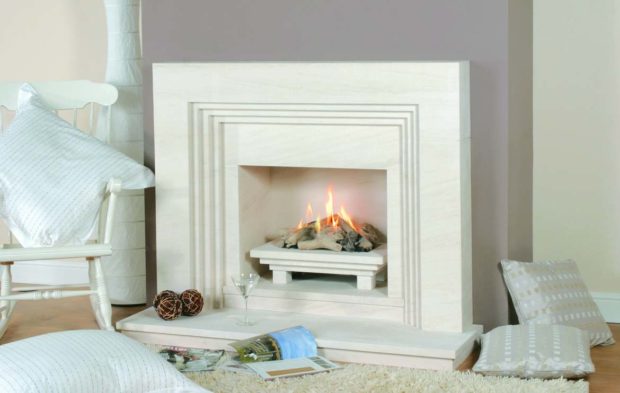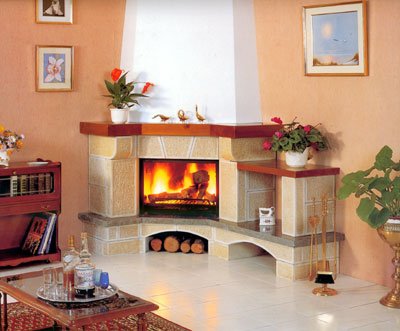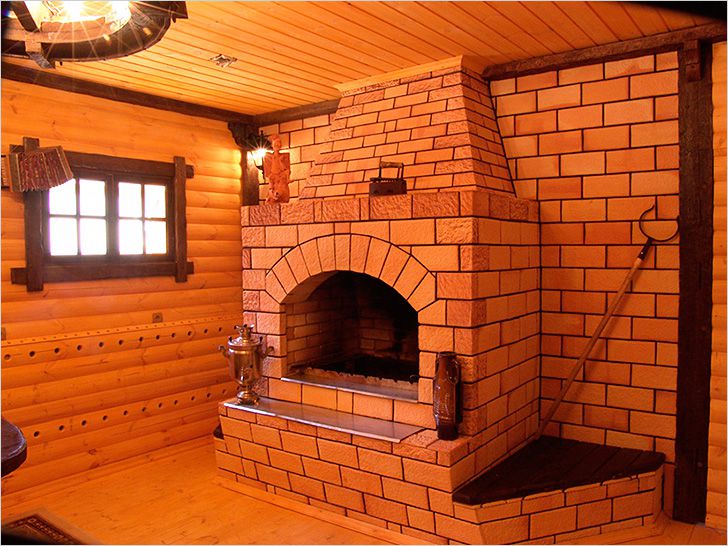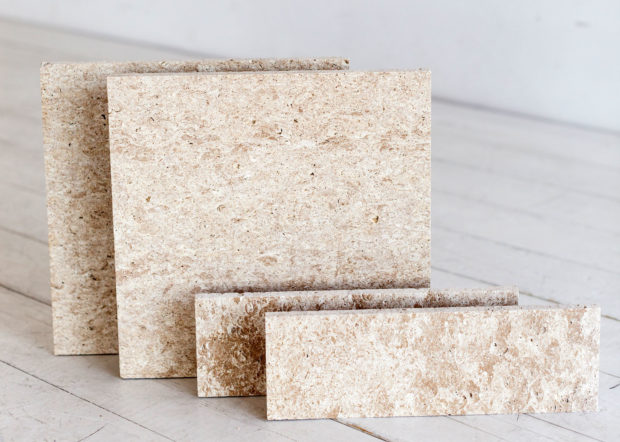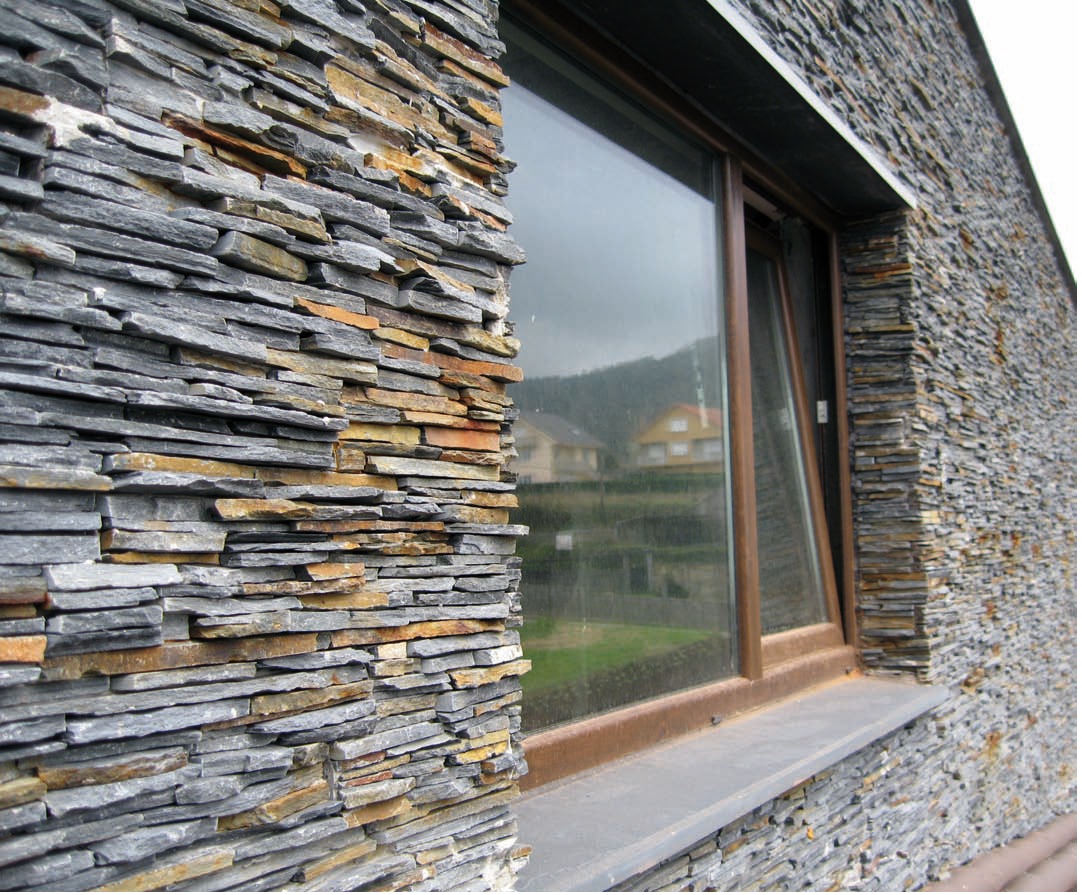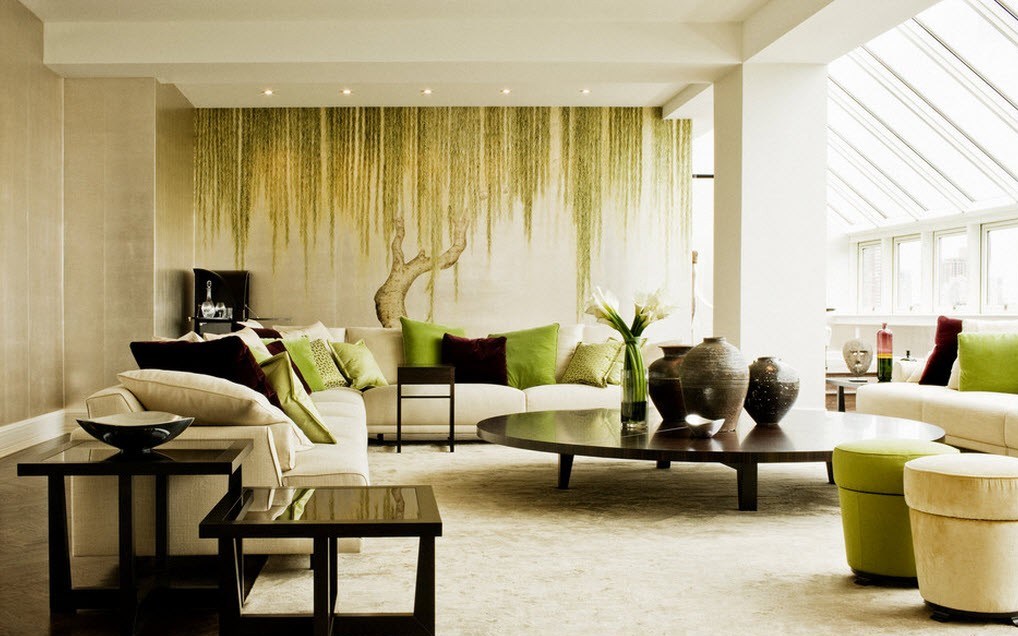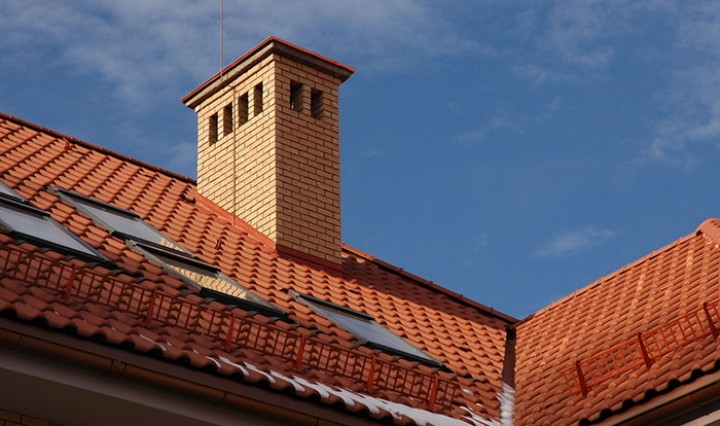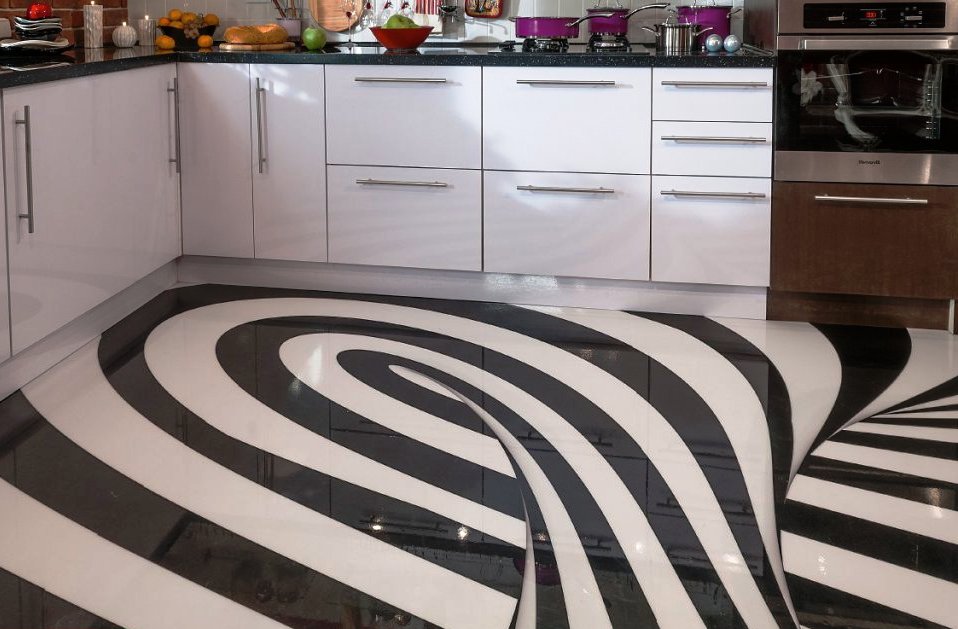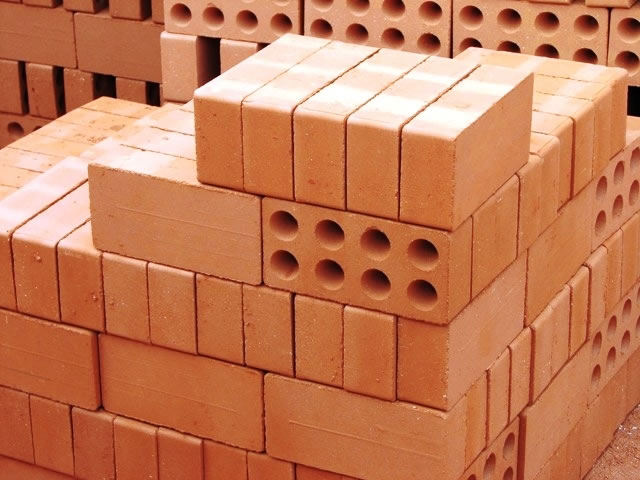Fireplace decoration: 8 materials for fireplace mantel + photo
Fireplace ... At the mere mention of this word it immediately blows warmth and comfort. The fireplace can become the center of the living room, a place where you can calmly and quietly spend winter evenings. Today, not only the owners of country houses can afford such a pleasure - for ordinary apartments there are false fireplaces that perfectly imitate real hearths, and electric fireplaces. When we move from dreams to realization of plans, a lot of questions arise. One of them is the decorative decoration of the fireplace. We figure out what materials for a fireplace lining can be used, and what the choice depends on.
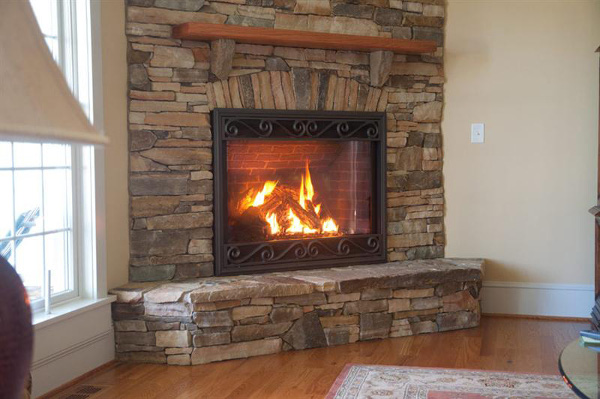
What should be the facing of the fireplace?
Because fireplace options it’s difficult to name the ideal finishing material. It all depends on a lot of factors.:
- type of fireplace. The material for the wood fireplace should be selected as carefully as possible, given the constantly acting high temperature. If you decide to stop at a fireplace mimic with candles or at electric version, then the requirements for decoration will not be so stringent;
- fuel type. The combustion temperature of different types of fuel is different, which must be taken into account when analyzing the parameters of finishing materials. For example, if you intend to use firewood, it is important that the lining withstands temperatures of around 9000C, if we are talking about coal, it is better to take a material that tolerates temperatures of the order of 11000FROM;
- place of installation. If you are going to install a fireplace on the terrace, it is important that the material has excellent frost resistance. Provided that it is used in a heated room, such a requirement is not advanced. If the fireplace is located in a house where there are only occasionally, then pay attention to such a parameter as moisture resistance;
- material weight. Material that is too heavy (such as natural stone) may require reinforcement. foundation, which is possible only in a private house and when installing on the ground floor. If it comes to an apartment or the upper floors of a private house, then you should definitely consider what load the ceilings can withstand;
- appearance. Cladding is also a cladding to decorate a fireplace, therefore, when choosing a material, it is worth considering its appearance and compliance with the chosen interior style and color scheme.

No. 1. Fireplace mantel
Tile is the most popular way to decorate a hearth. Use regular tile You can’t - it can’t stand the high temperature. As a rule, these types of ceramic tiles are used for facing a fireplace:
- terracotta tile It is made from fired clay, it has a beautiful natural reddish tint. Most properties reminiscent of refractory red brick, from which fireplaces are laid, therefore, when the temperature rises and falls in the furnace, the tile will expand with it. Terracotta tiles have a smooth coarse-grained structure. Additional pigments are not used in the manufacture, but the natural range of shades ranges from light brown to almost black;

- majolica It is also made from burnt clay, but it is covered with painted glaze on top, therefore it costs more, but it also looks very beautiful. When decorating a fireplace with majolica, you need to carefully consider the sketch, because cutting such a tile is not only impossible, but very stupid. In addition, the installation requires sufficient skill from the master, because the slightest flaws will be clearly visible. Due to the high cost and difficulties in our work, fireplaces very rarely finish only with majolica - they usually use it fragmentarily, as an accent and decoration. Such a solution looks gorgeous;

- brick tile It is made of special refractory grades of clay, therefore it is able to withstand high temperatures, and is also characterized by excellent frost resistance and moisture resistance. The color scheme is represented by shades of brown and terracotta, but thanks to various technologies for decorating the surface, you can get very interesting options;

- fireclay tiles it accumulates heat energy well, cools for a long time, keeps heat well. The material will expand with the fireplace body, can withstand extremely high temperatures. Fireclay tiles are thicker than terracotta.

This group is sometimes classified as porcelain tiles and tiles, but the uniqueness of their characteristics makes us consider each of these materials separately.
Tiling the fireplace has a mass the benefits:
- resistance to high temperatures, the ability to "breathe" with the fireplace;
- high heat transfer and the ability to accumulate heat, which increases heat transfer;
- moisture resistance, frost resistance, resistance to sunlight;
- simplicity in leaving;
- durability;
- environmental friendliness, lack of smells when heated;
- chic appearance and ample selection.

It’s hard to name the minuses - unless the price of some products can scare off. For the installation of tiles take not ordinary tile adhesive - necessary heat resistant composition. Can make a special clay composition yourself, but you will need to find a suitable clay and experiment with the proportions, so it’s easier to stay on the finished version.
It is better to buy tiles with a margin of 10-15%, and you can buy not only products of a standard format, but also corner elements. Mounting does not require special skills and the use of specific tools:
- preparatory work consist of removing the old cladding from the fireplace. After this, it is also advisable to embroider the masonry seams 1 cm deep. The dust is thoroughly eliminated, the brick is wetted with water. Using heat-resistant mastic or clay mortar, eliminate small irregularities. In the presence of significant deformations, it is better to use a grinding wheel. If the brick began to crumble, then it does not interfere with installing a reinforcing metal mesh with a mesh size of 1.5 cm;
- Before starting work, it is necessary to melt the fireplace for several hours so that the brick warms up sufficiently. The tile itself should be in the room where the work will take place for 48 hours;
- fireplace surface primedby reducing dust levels and improving adhesion. The primer should be allowed to dry for about 2 hours;
- the tile can first be laid out on the floor to understand which elements will have to be trimmed;
- glue is prepared according to the instructions indicated on the package. Mixing is best done with a construction mixer, but also drill with the appropriate nozzle will do;
- masonry begins with special corner elements, if used. Then the lower rows are mounted;
- the adhesive solution is applied with a flat spatula, and immediately for installation of 3-4 elements. To ensure that the distance between the tiles is the same, use special crosses;
- after tile installation overwrite seams. To do this, use special store solutions or a clay mixture with sand and dyes prepared by hand;
- when everything dries, it is desirable to cover the surface of unglazed tiles with a layer of heat-resistant varnish. This will simplify subsequent care.
Analyzing the many advantages of the material and the simplicity of its installation, it is easy to guess why it has gained such high popularity.
No. 2. Natural and artificial stone for fireplace mantel
The stone in the decoration of the fireplace looks as organically as possible and may even resemble the Middle Ages, but the perception of the portal will largely depend on which breed of stone is selected (or which breed imitates artificial stone).
Concerning natural stonethen for the fireplace use such breeds:
- granite - hard rock, has a wide range of shades, does not collect scratches, easy to care for. The surface can be both wild (with “torn” edges) and smooth polished;
- marble - the most popular stone for decorating a fireplace. It features a huge assortment of shades, is relatively inexpensive, looks great;
- shell rock captivates with low price and easy handling. It looks great, but not very durable. It has a soft porous structure, so gradually soot particles will collect in the pores, spoiling the appearance. If you will rarely melt the fireplace, then the shell rock will do;
- limestone and sandstone differ in a sufficient number of shades, but can not boast of strength, and soot can remain in the pores of the material;
- slate - durable and beautiful material, but its peculiar appearance does not allow us to call the breed universal.

Natural stone has a high weight and a fairly high price, so today an artificial analogue is actively used. Natural stone for fireplaces for sale in the form of plates. Often this format is called stone tiles or flagstone. Since the shape of such tiles is usually different, it is better to first lay out all the elements on the floor so that it is possible to pick up and process all the elements in time. When installing natural stone, you can’t do without a mesh, otherwise the finish risks falling apart.
Fake diamond made on the basis of Portland cement with the addition of expanded clay or on the basis of gypsum. The mass is poured into the forms that they receive by making casts from natural stones. Such products cost less, weigh less, can have any color and shape, in terms of strength and other operational qualities they are practically not inferior to natural stone, and even surpasses some breeds.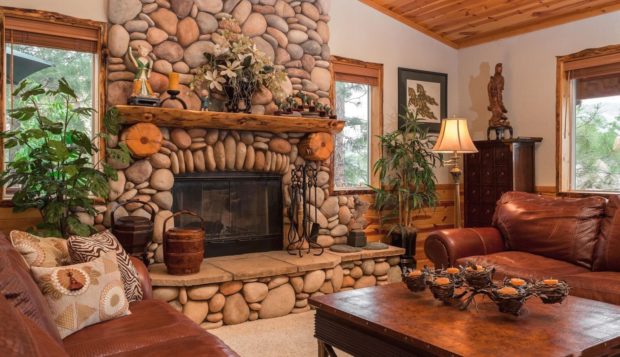
The main advantages stone fireplace lining:
- resistance to high temperatures;
- environmental friendliness and safety;
- chic appearance;
- durability;
- for artificial stone, ease of installation and processing, low weight, price;
- for natural stone - the uniqueness of each element.
Stone laying technology resembles the tile installation described above. Between the stones it is not necessary to leave gaps of the same size (as is the case with tiles), so that everything will be even simpler. For installation, they take a special heat-resistant adhesive for stone. The heaviest stones are recommended to be additionally fixed with anchors. Otherwise, everything is the same as with tiles. First, the surface is prepared, primed, glue is diluted, then the installation of stone begins from the bottom row. Before starting work, it is recommended to melt the fireplace, and place the stone on the floor in order to assemble the future "drawing". In the case of natural stone, the elements may have a slightly different shade. This must be considered in advance. Looks best when the bottom rows are slightly darker than the top. If desired, the stone is coated with heat-resistant varnish.
No. 3. Brick fireplace
This is not even a finish in the traditional sense of the word. In this case, there is no question of installing some kind of facing material on top of the fireplace. That the brick from which the fireplace is built, accordingly gets off.This is both simplicity and complexity of the method.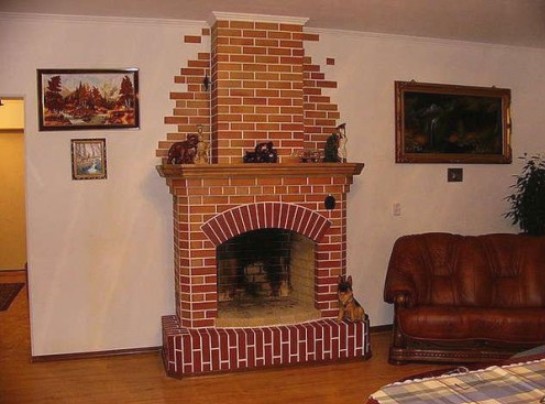
If you originally planned not to use any additional facing materials, then when laying the fireplace, the mortar must be laid so that 5-7 mm remain to the outer edge of the brick. Later this void will be filled with decorative grout. If the fireplace is already built, then it is possible to complete the jointing for the subsequent use of a grout of a certain color. You can not touch the brick, but you can polish or chamfer. Such work should be performed by an experienced specialist. Not every stove-maker is ready to do this, so it is better not to perform such a facing on your own. Brick can be treated with hydrochloric acid solution - so the material will acquire a more saturated color.
There is a more standard way. This is the finish facing ceramic brick plastic molding. Material normally withstands high temperatures, looks great and expands the possibilities of decor. Masonry is not much different from masonry of ordinary brick. True, you will have to monitor the evenness of the seams (as is the case with tiles), and then seal them with heat-resistant mastic.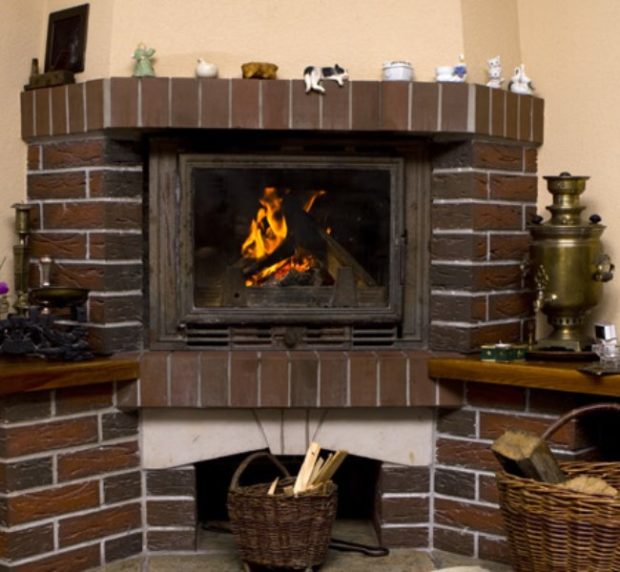
Number 4. Porcelain stoneware cladding
Porcelain Tiles - This is not a natural material, but it contains natural components. A special technology allows you to create material that It is not inferior in strength to natural stone. The composition includes clay, mica, sand, metal oxides, feldspar and granite or marble chips. Porcelain tile can repeat the pattern of any natural stone, different minimum pores, which explains its performance.
Material Advantages:
- wear resistance and high strength;
- the ability to withstand high temperatures, so that porcelain stoneware is definitely suitable for facing the fireplace;
- moisture resistance and frost resistance;
- environmental friendliness;
- ease of maintenance, resistance to mechanical damage and chemically aggressive substances;
- a huge variety of colors and textures. Porcelain tile can copy ceramic tiles, any kind of stone, majolica and clinker.

It costs porcelain tiles a little more expensive than terracotta tiles and can make it a decent competition. Of the main cons: higher weight and relative complexity in processing - cutting porcelain tiles is not as easy as tile. However, for facing the fireplaces use plates of material with a small thickness, so that there will be no significant load on the floors. If at home it is difficult to perform cutting, you can entrust this task to special firms.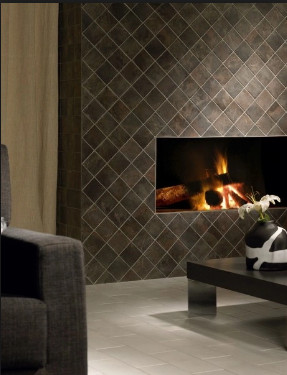
Installation of porcelain tile carried out on glue or on a metal frame. The first method is actually identical to the tile installation described above, so it makes sense to dwell in more detail on the second option:
- a frame is created from the metal profile around the perimeter of the fireplace; anchor bolts are used for fastening. Profiles are connected with self-tapping screws. The step between the profile should correspond to the format of porcelain tile;
- using special staples, porcelain stoneware is fixed on the frame;
- the space between the brickwork of the fireplace and porcelain stoneware must be filled with clay mortar with the addition of sand and gravel;
- joints of porcelain tiles are treated with a composition of clay, sand and color pigment;
- after the work is completed, the fireplace needs to be heated for a couple of days - this is how clay is sintered and forms a denser layer with a high degree of heat capacity.
In this way, it is convenient to clad fireplaces with a lot of bumps, defects and slopes, because with the help of a metal frame and mortar they are all leveled.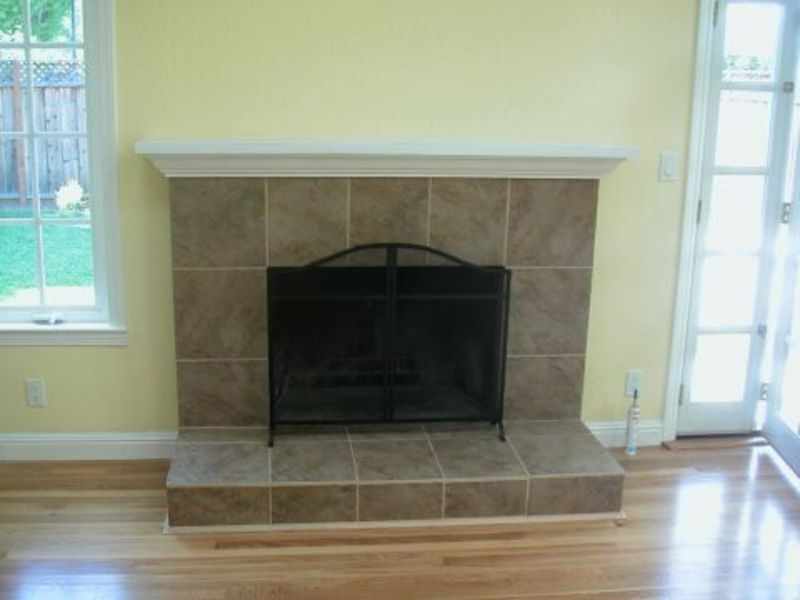
No. 5. Cladding for fireplace
Most simple and budget way to finish a fireplace is to cover it with a layer of plaster. Moreover, with plaster you can to form both a smooth and decorative relief surface (using different spatulas, brushes, rollers and even household items, such as plastic bags, you can achieve an incredible result). With proper dexterity, even the texture of the stone can be conveyed. Stucco can be painteddo drawings on it. The appearance of a plastered fireplace is very easy to change by simply repainting it. Plaster weighs a littleso that there is no significant load on the floor. Finish comes out durable and practical, if, of course, choose the right composition.
For plastering fireplaces it is better to take the same composition that is used when working with stoves. The easiest way is to buy finished material, in which the manufacturer added the necessary additives and additives. For those who know how and love to do everything with their own hands, there is a more complicated way - self-preparation of a stucco mortar. It consists of clay, sand and lime, but in order for the solution to have the necessary operational qualities, it is important to choose the clay fat content and the proportion of clay and sand correctly - all this is done through experiments. To be sure that such plaster does not crack and withstand heat, experience will be required.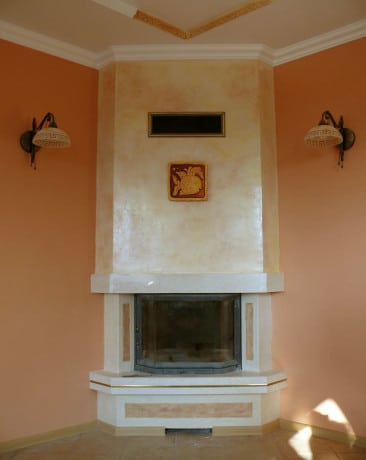
Many manufacturers offer both basic and finish plaster. The first is applied with a layer of 10 mm, intended for rough finishing and preparation of a flat base. The final layer is applied with a thickness of 3 mm.
The process of plastering a fireplace not much different from wall plaster:
- all old cladding, if any, is removed;
- to increase adhesion, it is better to expand the masonry joints to a depth of 0.7-1 cm. A chisel or screwdriver is suitable for scraping the solution;
- it is better to seal the cracks with heat-resistant sealant;
- if the walls of the fireplace are relatively even (height differences and the depth of the depressions does not exceed 5 mm), then you can moisten the brick and proceed to the application of plaster. With more significant irregularities, reinforcement with a reinforcing mesh will be required. It is attached to masonry brick. nailson the caps of which they wear metal washers;
- Before starting work, it is better to melt the fireplace so that the brick acquires the dimensions that will be characteristic of the operation of the fireplace. If the base is not warm, then the plaster may crack at the very first firebox;
- ready-mixed plaster mortar is applied with a spatula and leveled with beacons. It is recommended to apply at least two layers of plaster, and each subsequent is applied after the previous one has finally dried up. The finish layer can be leveled with a spatula. On it you can create a specific relief.
For additional decor, you can use paints. Organosilicones that are good are best suited. tolerate heat to high temperatures. The hearth can be painted in the same color or you can draw certain patterns on it - it all depends on the imagination, skills and interior.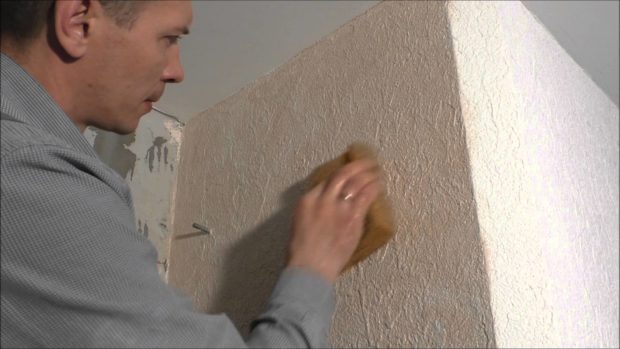
No. 6. Tiling
Tiles are, in fact, the same terracotta tiles or majolica. The difference lies in the special structure. The tiles have a rump, a square hollow ledge with which the tile is fixed during installation. Rump is important for another purpose - it helps to retain heat. Tiles can only be trimmed during masonry. If a moment is missed, you will have to choose a different finishing method.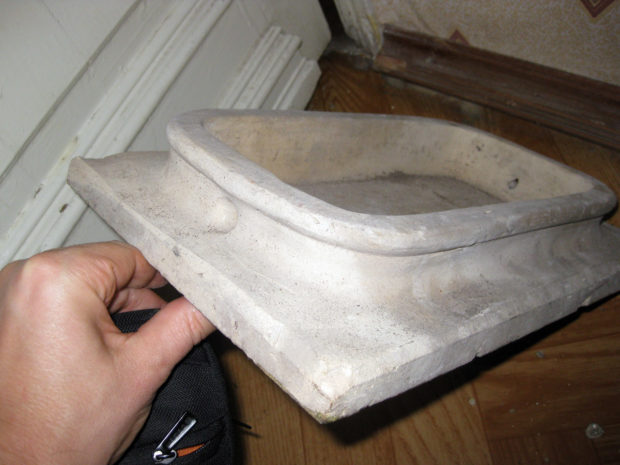
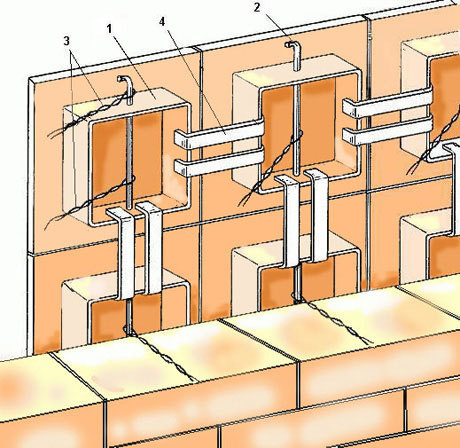
For tiles, the same advantages are characteristic as for tiles. The choice of colors is huge, there are very exquisite designs that will bring a special chic to the interior.
Tiles are mounted in this way.:
- ½ rump is filled with a mixture of clay and broken brick, so-called soils are inserted into special holes crutch, thick (5 mm in diameter) wire with a bend at the top;
- In the middle of the crutch, a flexible soft wire is attached, which will later be embedded in brickwork;
- rump is filled with clay mixture to the brim;
- as masonry, tiles are mounted, the wire is hidden in the seam. Between themselves, individual parts are connected by U-shaped brackets.
It’s difficult to do such a do-it-yourself installation, which makes arranging a fireplace a more expensive pleasure.In addition, the material itself is more expensive than ordinary tiles.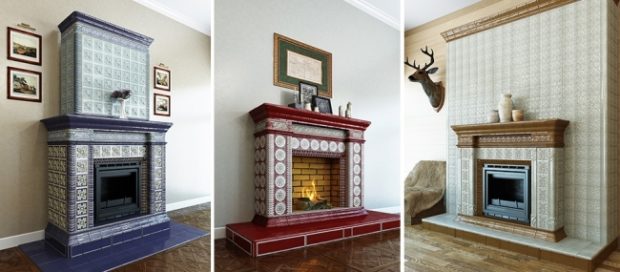
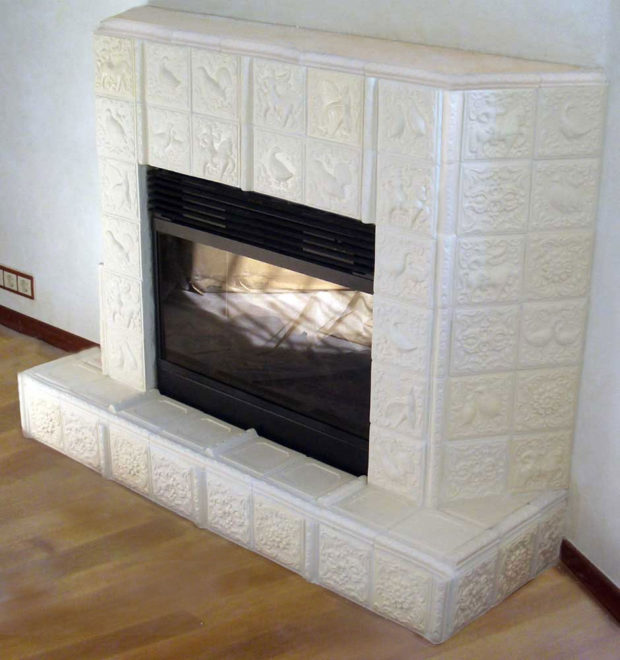
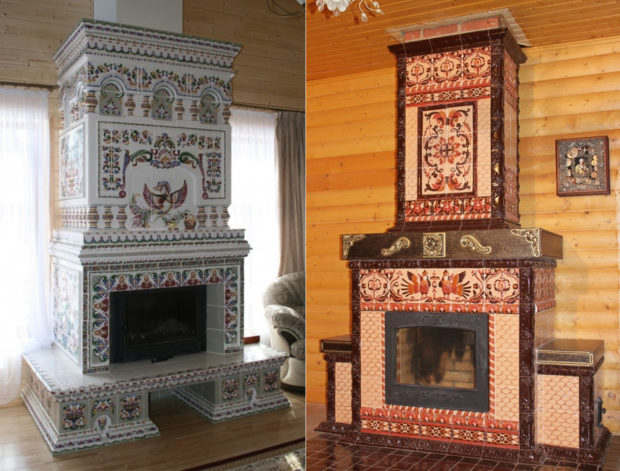
Number 7. Wood fireplace mantel
Probably, many may find this way of facing impossible, because it is no secret that the tree is very afraid of fire. Nonetheless, when certain rules are followed you can decorate the hearth with warm and cozy wood - such a fireplace will look great in the living rooms, made in the classical style. Wood is an aesthetic, durable and natural material that has a special aroma. To enjoy these benefits, you have to observe a number of conditions:
- you must choose rocks that are resistant to high temperatures and not very susceptible to deformation at constant temperature changes. It is clear that all species of wood burn without exception, but those that have a denser structure ignite much later. Suitable for decorating the fireplace oak, hornbeam, maple, cherry. Larch has average density, and pine, cedar and linden should not be considered at all;
- is necessary impregnation special meansthat will prevent fire. These are flame retardants that penetrate well into the structure of a tree;
- the tree is better to arrange as far from the hearth. Therefore, consider partial wood finishes or create a niche for installing cladding 5-10 cm more than a brick frame. Then the tree will heat up within acceptable limits;
- in any case, it’s better to cover the firebox protective screenso that sparks do not fall on the wood.

Number 8. Drywall for fireplace mantel
Drywall is often used in the decoration of electric fireplaces. Material allows create any shape for the hearth. Actually, thanks to this feature drywall and has become so widespread. The main advantages of the method include low cost, simplicity mounting (only the lazy today do not know how to work with drywall) and, of course, a wide scope for imagination. We take into cons the need for additional decorative finishes and complexity in terms of ensuring the safety of the structure.
The principle of work is as follows:
- creating a frame from a metal profile. At this stage, you can create almost any form;
- inside the frame is upholstered with sheets of magnesite (glass magnesium sheet) that can withstand temperatures up to 12000C, it can resist open fire for 2 hours, is characterized by high strength and sufficient flexibility. It is waterproof, easy to install, has good thermal insulation properties;

- plates are stacked in a metal frame basalt wool, which will protect drywall from overheating;
- for facing take gypsum plasterboard refractory sheetswhich perfectly withstand continuous heating up to 1300C and above, for 45 minutes they can resist open fire. In addition, the crystallized water in the core acts as a fireman for himself;
- when mounting sheets and insulation, holes should be provided along the edges of the fireplace, which will serve for better air circulation;
- joints of gypsum plasterboards should only be on frame elements;
- when the cladding is finished, you can proceed with facing with plaster, tile or artificial stone.

Remember that you can always combine several materials.
When it comes to false fireplace, from which, if heat comes, it’s only insignificant, you can use any materials you like.

